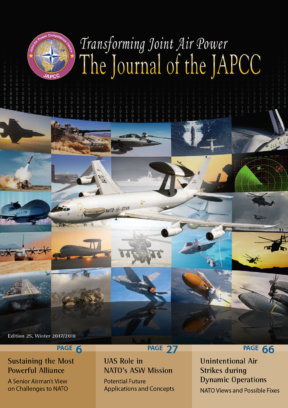Introduction
Images of bombed hospitals stunned participants of the 2016 JAPCC Conference1, as a Panellist raised the unsettling and poignant issue about how operations sometimes transcend military objectives. Specifically, the panellist expressed concern about ‘recurring kinetic strikes against civilian and/or medical facilities and what is being done to prevent further occurrences’. Discussion of the topic exposed significant differences in opinion about the reasons for, and prevention of, such strikes. Subsequently, the JAPCC hosted a meeting of interested parties to further a better understanding of positions and attempt to find ideas for a way ahead that would minimize, if not eliminate, the problem. The meeting and follow-on research revealed several areas where military and civilian organizations could improve training and preparedness to prevent such incidents in the future.
Recent Occurrences
Between 2012 and 2014, the International Committee of the Red Cross (ICRC) documented nearly 2,400 attacks against health workers, patients, and medical facilities and transport units, in just eleven countries. The vast majority of these attacks were against local medical facilities and personnel. In September 2015, the World Health Organization (WHO) reported 654 medical personnel had been killed since the beginning of the conflict in Syria, and that almost 60 percent of hospitals were either partially functional or completely out of service. Since 2015, nearly 100 medical facilities operated by Non-Governmental Organizations (NGO) have been bombed. The vast majority of these were in Syria, but facilities in Yemen, Afghanistan, Ukraine, and Sudan were also hit. It is extremely difficult to determine how many incidents were caused by NATO-led coalition assets versus the local government’s or other nations’ militaries.
These are only a few examples of fatal air strikes conducted by different entities against hospitals operated by NGOs:
- Afghanistan, 3 October, 2015. The Kunduz Trauma Centre was heavily damaged in an airstrike conducted by a NATO asset.
- Syria, February 2016. An air raid hit the Maarat al-Numan Hospital. There is no clear evidence to confirm which nation or coalition is at fault.
- Syria, 27 April, 2016.The Al Quds hospital in the northern part of Aleppo was completely destroyed by an airstrike. There is no clear evidence to confirm which nation or coalition is at fault.
- Yemen, 16 August, 2016. A hospital was hit when the Saudi-led coalition conducted an air strike in the Abs district of Hajja province.
These tragic situations are every commander’s worst nightmare. No one would argue that intentional strikes on such legally protected sites are permitted if they are used in violation of the laws of armed conflict, but the lack of awareness of the nature of the site and/or the alleged military use of the site can often result in devastation to civilian infrastructure and personnel. The confusion and stresses of dynamic targeting can often exacerbate this lack of awareness and/or confusion of enemy location, with fatal results.
Fictitious Example
Let us look at a fictitious but nevertheless realistic example. The situation is ‘Troops in Contact (TIC)’ and ‘Danger Close’ in the suburbs of a city, near a bridge on a winding river. ‘TIC’ means that our fellow fighters are being engaged, and the term ‘danger close’ is included in the call for fire support indicating there are friendly troops or positions within a given, close distance of the target.2
A powerful air asset is called to intervene, coming from a different part of the area of operations, making an already long flight even longer. It is late in the day for the crew. When the attack aircraft arrives, contact is established and the talk-on to the target begins. The aircrew is provided with coordinates on the ground (the friendly position, the hostile position, concerns positions) and other details. Unfortunately, the airplane’s erroneous navigation system places the targeting pod’s crosshairs somewhere on the river instead of on the target. Aircrew and ground troops start exchanging information, trying to manually guide the errant targeting pod to a valid, legal point on the ground. The building seen matches the building described. The relative position to the bridge checks. The aircrew obtains clearance from the ground and engages. A building is hit repeatedly, and hostile fire ceases on friendly troops.
Success? No, not entirely. While the hostile troops perceived the air-to-surface fire as a significant threat and stopped their ambush, the building that was just hit was not the one they were hiding in. Unfortunately, it was an unmarked hospital run by an unidentified NGO, and one that the crew of the attack aircraft was not aware of.
What happened? The truth can be complex. Perhaps there were two similar bends in that river, two alike bridges and south of those bridges quite comparable buildings matching the description just received. Such a constellation is plausible in many cities. The crew had little time to decide and act, and the troops on the ground were taking fire. There were no obvious markings on the building, no other building was briefed, and no one noticed differences. The crew did not doubt what looked right and engaged what they thought was the target building.
Avoidance of Fratricide and Collateral Damage
The example above is a typical case of an Immediate Request for Close Air Support (CAS), which usually results from unanticipated or unplanned emergency needs on the battlefield and requires diverting or rescheduling aircraft from other missions.3 CAS is air action against hostile targets in close proximity to friendly forces, which require detailed integration of each air mission with the fire and movement of those forces.4 When executing CAS, risk assessment is a critical factor in preventing both fratricide and collateral damage. NATO doctrine prescribes due diligence should be applied in order to minimize, and ideally avoid, any loss of civilian life, injury to civilians, or damage to civilian objects.5
While this all sounds good in theory, the strain of dynamic operations in practice often exposes weaknesses in man and machine, which could lead to undesired effects. Factors such as unexpected developments, faulty systems and malfunctions, inadequate levels of training, human fatigue, and psychology may play a role. In addition, the value of a risk assessment before a strike is predicated on the aircrew having complete and accurate information about non-combatant groups and facilities in the area. In the absence of such information, there is no expectation of collateral damage or civilian casualties, and therefore no reason for the aircrew to assess alternative courses of action such as having friendly ground forces disengage and look for a new route.
Psychology’s Treacherous Trio
In our example above, the erroneous decision made by the aircrew to engage the wrong target could also be explained with a phenomenon known as ‘Psychology’s Treacherous Trio’. It consists of three psychological tendencies that when mixed together form a potent recipe for ignorance:
- Confirmation Bias. A natural propensity to look for what confirms what we believe and ignore what contradicts our belief.
- Cognitive Dissonance. A state of tension that occurs whenever a person holds two cognitions that are psychologically inconsistent.
- Motivated Reasoning. The human tendency to accept what we want to believe with more ease and much less analysis than what we do not want to believe.
If the aircraft’s navigation system was ‘off’ just enough to show only one bridge, the crew would have believed the building to be the correct one. Even if the targeting pod had shown both bridges, the crew may have assumed the system to be accurate. It could have been the ‘psychological treacherous trio’ that drove the crew to select targeting the bridge closer to the crosshairs.
How to Improve on the Military Side?
On the military side there are tools that could help prevent such errant strikes.
- Make sure aircrews have detailed maps or charts available showing the locations of all known formal and informal hospitals in the Area of Operations, just in case they are diverted from a planned mission to answer a distress call from ground forces.
- Increase the use of technical capabilities for networked exchange of information. Modern systems are capable of receiving a digital brief directly from the involved ground troops, similar to real-time traffic information fed into modern car navigation systems.
- Implement more accurate navigation systems connected with the aircraft’s targeting systems.
- Improve crew training. While an accurate navigation and targeting pod system help zeroing in, it is still the human that makes the decision to engage. The best weapon kit may not be enough in a dynamic environment, where nothing is more important than human observation and intellect. Recurring training aspects could be:a) Communication capabilities of the aircrew, i.e. the talk-on procedures to exchange more accurate details about the situation concerning the target.b) Psychological human factors as described above. Awareness of these dangerous proclivities may help prevent their unfortunate effects.
How to Improve Self-Protection on the Civilian Side?
NGO’s and the ICRC can also help reduce the probability of medical facilities falling victim to an unintentional military strike. Under the international Law of Armed Conflict (LoAC), the Geneva Conventions Protocol I unmistakably codifies that medical units shall be respected and protected at all times and shall not be the object of attack. In the same context, the Protocol is very clear that Parties to the conflict are invited to notify each other of the location of their fixed medical units and shall ensure that medical units are so situated that attacks against military objectives do not imperil their own safety.
Therefore, besides carefully choosing the location of the medical facility, the use of distinctive, recognized, and clearly observable markings on the buildings is paramount in zones of conflict to safely protect qualified structures from military attack. Vertical signs, whether on the external building walls or free-standing, are usually not large enough to be visible to aircrews from above. Therefore, organizations need to put horizontal markings on the roof, or on the ground right beside the building, which are large enough to be seen by the naked eye or through a targeting lens from hundreds of metres in the air. In accordance with the Geneva Conventions, these could be the Red Cross, the Red Crescent, or the Red Lion, to name only a few examples. Some humanitarian organizations want to be recognized as non-aligned or non-affiliated and therefore prefer not to use those signs. In this case, the red diagonal on a white square background has been specially designed. Aircrew know and understand these signs, and they will not deliberately ignore them. If an aircrew observes such symbols on a targeted building, they will most likely seek more information about the nature and occupants of the building before deciding whether or not to execute the strike. Apart from the symbol itself, special attention should be given to its size and the type of paint. For best observation from the air, the sign should be put on flat portions of the roof and must be large. The edge length should be 2–3 metres at a minimum. The paint of such markings should also be observable at night with Night Vision Goggles or IR sensors. There are paints that react with sunlight and therefore are more visible at night because they have retained heat, which will provide a different and improved response to sensors detecting white/black contrast.
Unfortunately, many NGOs are quite reluctant to contact and cooperate with Military HQs, for a number of reasons. First of all, NGOs tend to closely guard their independence and do not want to appear affiliated to any official or governmental agency or entity. Second, they often provide support to personnel without regards to status or nationality (i.e. NGOs may assist enemy combatants), which can put them at odds with ‘friendly’ troops. Finally, they often believe that the average military ‘NATO’ HQ is impenetrable and not permeable to discussions and cooperation. On the other hand, it also has to be said that sometimes coalition HQs treat NGOs with suspicion and are not prepared to share information and cooperate. One possible solution, to have a better understanding and mutual trust, could be to have regular meetings in a ‘neutral’ site to share information, programs/activities and maybe organize combined relief exercises which do not fall under a specific colour flag. This may require specific allowances for NGO sensitivities but could generate great dividends.
Furthermore, establishing contact with the military to report and stop an actual unintentional attack could be practical. A simple phone call might suffice but could also lead to a prolonged process to gain situational understanding and resulting in a delayed decision. The use of an emergency communication system is probably the better option. The Aeronautical market offers various solutions such as a radio transmitting on established emergency frequencies or an Emergency Locator Transmitter (ELT). Modern ELTs can be registered and given a ‘call sign’. When the emergency occurs the device transmits a coded signal on the emergency frequency, audible as a beacon and broadcasting its own call sign. An aircraft crew engaged in an attack could be notified within seconds of the ELT activation and possibly correlate the activation with the engagement.
Conclusion
When countries, alliances, coalitions or factions engage in a confrontation, this may often result in devastating effects. Often, not only the engaged parties pay the price. This perception, however, does not liberate anyone from taking all appropriate measures to avoid collateral damage as well as unnecessary suffering in line with the provision of the LoAC.
On the military side, improvement of technical capabilities for the exchange of target information and precision strike is one obligation. The other one will be procedural training to include education about the psychological influences on human decisions. Despite the susceptibility of the human mind to mistakes, the human-in-the-loop’s cognitive reasoning is often the last line of defence in confusing environments.
Nevertheless, it is important to note that military technology, procedures, and (mental) training are not the only critical factors when it comes to avoiding unintentional strikes on civilian targets. There is also a civilian responsibility. In particular, humanitarian organizations inside the zone of conflict should take the necessary precautions such as appropriately marking their medical facilities and establishing emergency communication with coalition forces’ military headquarters. Maintaining neutrality does not require maintaining anonymity, and better self-identification could be a major step in self-protection.
Western air forces do not intentionally target known medical facilities in conflict zones, yet these strikes have continued to happen, with regrettable losses of dedicated medical personnel and their patients. Both the militaries involved in a conflict, and medical organizations attempting to impartially treat wounded civilians and combatants from both sides, can take steps to increase the awareness of hospital locations in order to reduce, or better yet, eliminate such accidents in the future.













